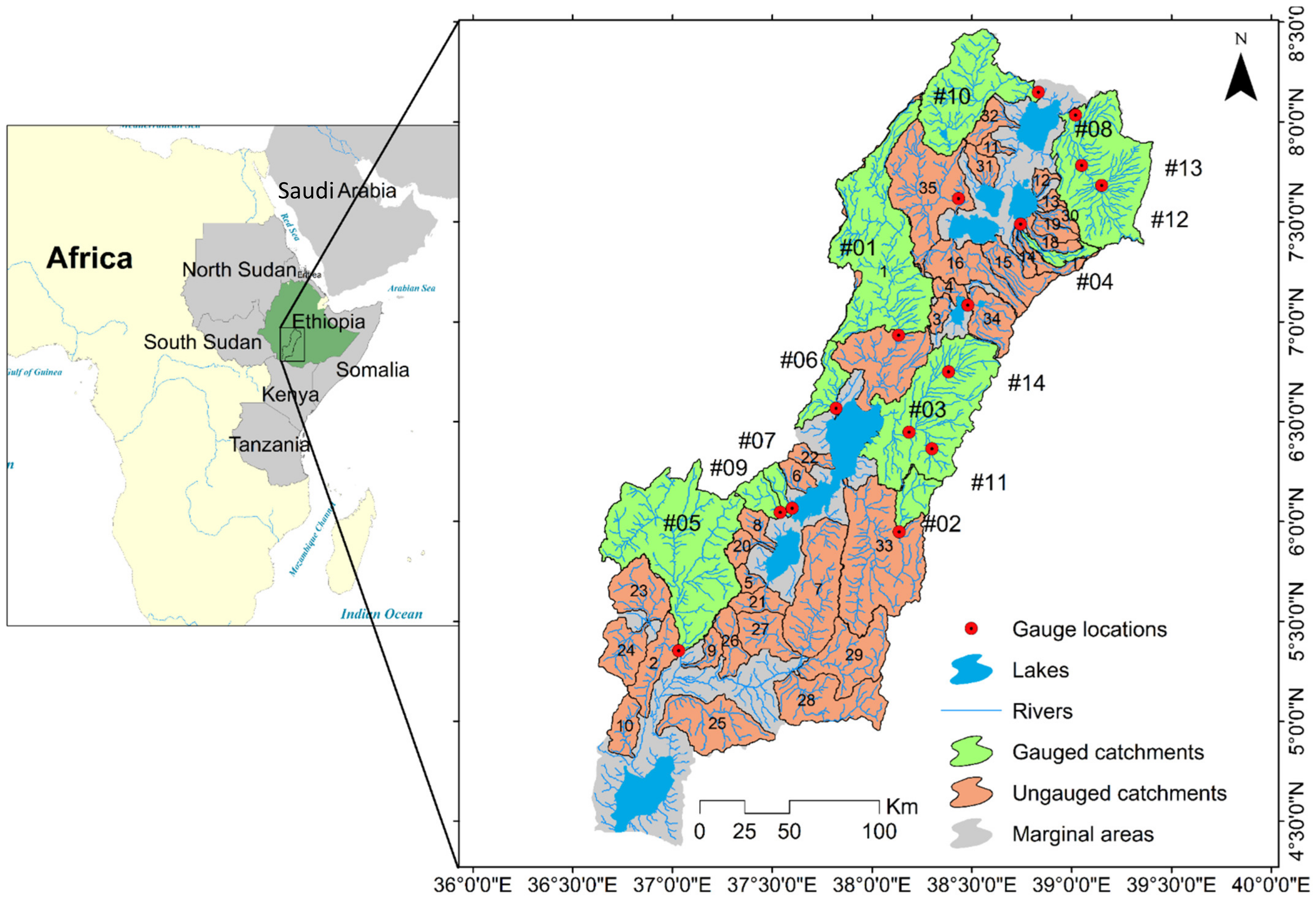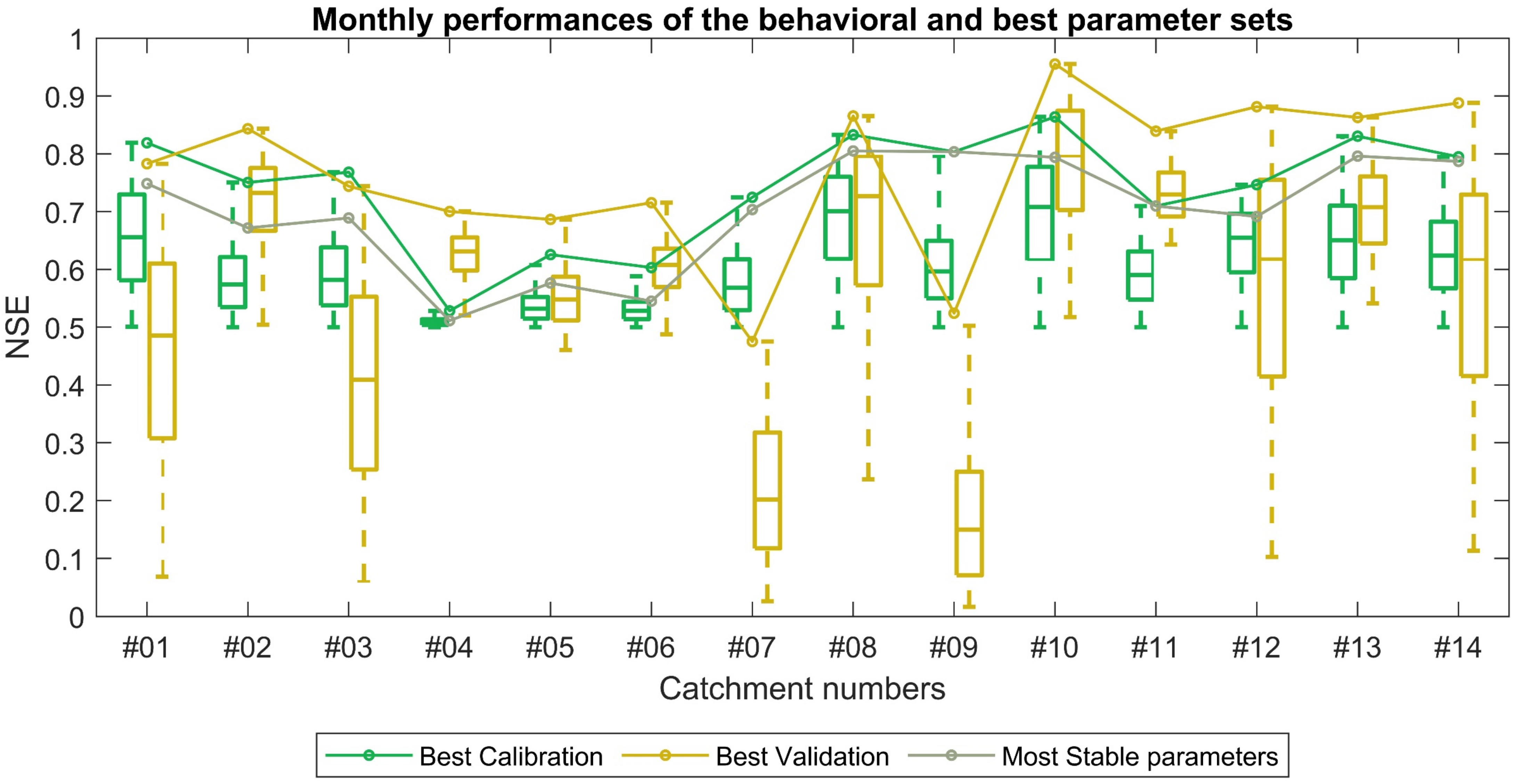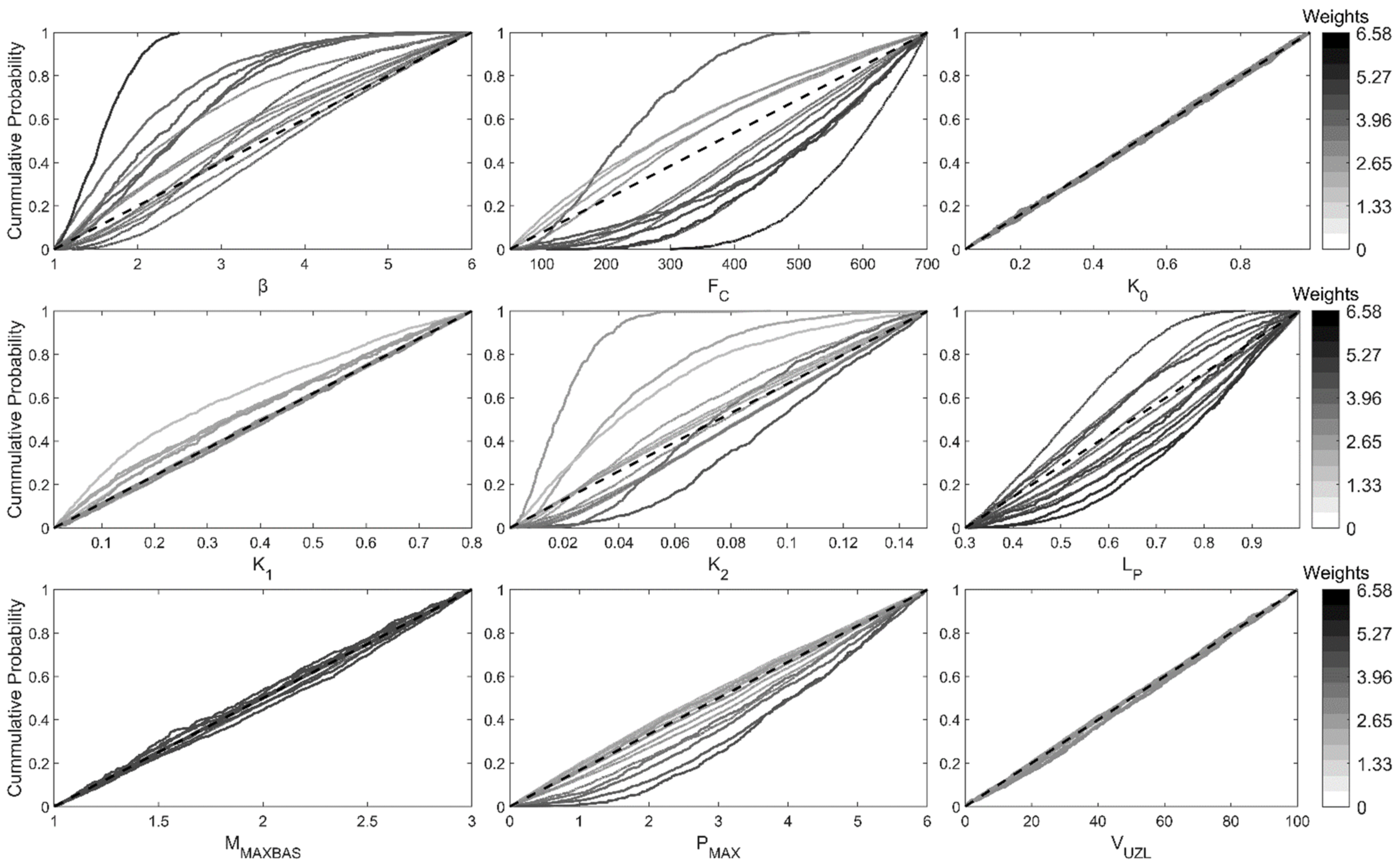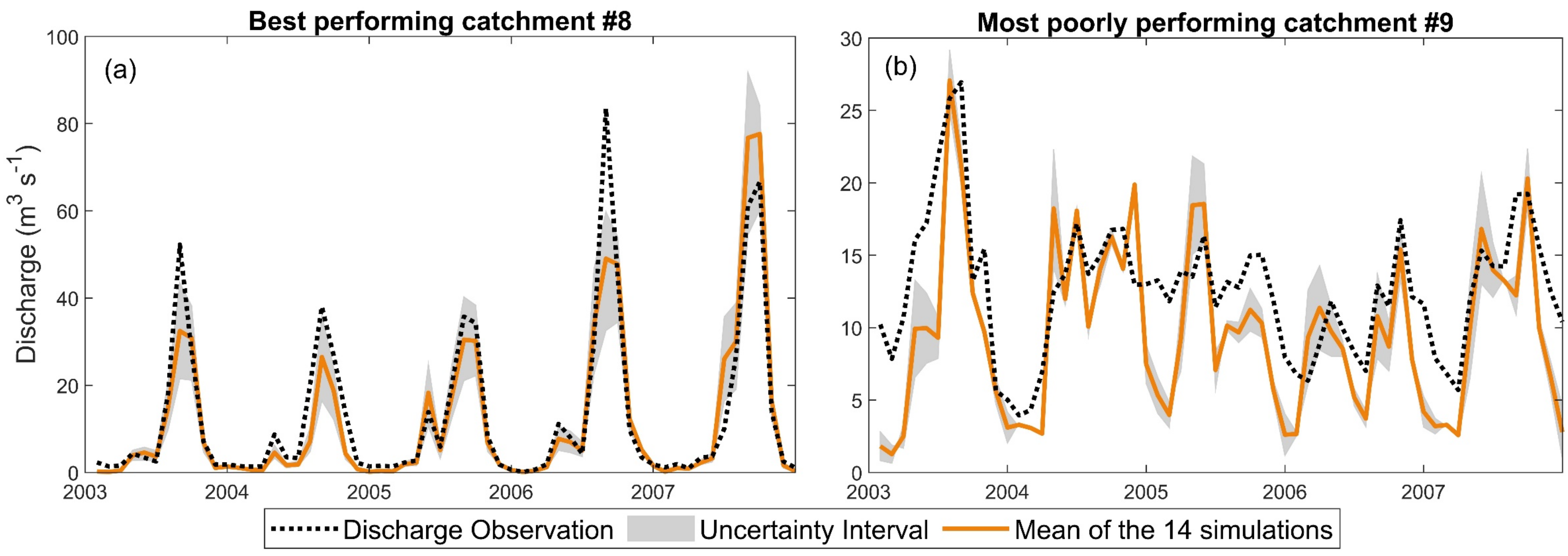Prediction at Ungauged Catchments through Parameter Optimization and Uncertainty Estimation to Quantify the Regional Water Balance of the Ethiopian Rift Valley Lake Basin
Abstract
:1. Introduction
2. The Study Area
Data and Catchment Properties
| Variable | Spatial Resolution | Time Period | Temporal Resolution | Source | Reference |
|---|---|---|---|---|---|
| Precipitation | 0.1° | 1995–2007 | Daily | MSWEP V2 | Beck et al. [41] |
| Potential evapotranspiration | 0.25° | 1995–2007 | Daily | GLEAM v3 | Martens et al. [43] |
| HBV-parameters | 0.5° | - | - | www.gloh2o.org (access date 12 January 2020) | Beck et al. [30] |
| Elevation | 30 m | - | - | SRMT V2.1 | https://earthexplorer.usgs.gov (access date 28 January 2020) |
| Wetness index (P/PE) | Point scale | 1995–2007 | Daily | MSWEP V2 and GLEAM v3 | Beck et al. [41]; Martens et al. [43] |
| Streamflow | Pont scale | 1995–2007 | Daily | MOWIE | - |
3. Methods
3.1. Hydrological Model
3.2. Parameter Estimation in the Gauged Catchments
3.3. Parameter Estimation in the Ungauged Catchments
3.4. Evaluation and Uncertainty Estimation of the Regionalization Procedure
3.5. Estimation of Regional Resilience of Streamflow to Precipitation Variability
4. Results
4.1. Estimated Parameters in the Gauged Catchments
4.2. Performance of the Regionalization Procedure
4.3. Estimation of Regional Resilience of Streamflow to Precipitation Variability
5. Discussion
5.1. Reliability of the Regionalization Approach
5.2. Parameter Sensitivity and Spatial Variability
5.3. Estimation of Regional Resilience of Streamflow to Precipitation Variability
5.4. Transferability of the Approach to Other Catchments and Models
6. Conclusions
Supplementary Materials
Author Contributions
Funding
Institutional Review Board Statement
Informed Consent Statement
Data Availability Statement
Acknowledgments
Conflicts of Interest
References
- Woldegabriel, G.; Aronson, J.L.; Walter, R. Geology, geochronology, and rift basin development in the central sector of the Main Ethiopia Rift. GSA Bull. 1990, 102, 439–458. [Google Scholar] [CrossRef]
- Stokstad, E. Scarcity of Rain, Stream Gages Threatens Forecasts. Science 1999, 285, 1199–1200. [Google Scholar] [CrossRef]
- Blöschl, G.; Sivapalan, M.; Wagener, T.; Viglione, A.; Savenije, H. Runoff Prediction in Ungauged Basins: Synthesis across Processes, Places and Scales; Cambridge University Press: Cambridge, UK, 2011. [Google Scholar]
- Sivapalan, M.; Takeuchi, K.; Franks, S.; Gupta, V.; Karambiri, H.; Lakshmi, V.; Liang, X.; Mcdonnell, J.; Mendiondo, E.; Connell, O.; et al. IAHS decade on Predictions in Ungauged Basins (PUB), 2003–2012: Shaping an exciting future for the hydrological sciences Catchments as space–time filters—A joint spatio-temporal geostatistical analysis of runoff and precipitation. Hydrol. Sci. J. 2003, 48, 857–880. [Google Scholar] [CrossRef]
- Wagener, T.; Wheater, H.S.; Gupta, H.V. Rainfall-Runoff Modelling in Gauged and Ungauged Catchments; Imperial College Press: London, UK, 2004. [Google Scholar]
- Guo, Y.; Zhang, Y.; Zhang, L.; Wang, Z. Regionalization of hydrological modeling for predicting streamflow in ungauged catchments: A comprehensive review. WIREs Water 2020, 8, e1487. [Google Scholar] [CrossRef]
- Pool, S.; Vis, M.; Seibert, J. Regionalization for Ungauged Catchments—Lessons Learned From a Comparative Large-Sample Study. Water Resour. Res. 2021, 57, e2021WR030437. [Google Scholar] [CrossRef]
- Arsenault, R.; Breton-Dufour, M.; Poulin, A.; Dallaire, G.; Romero-Lopez, R. Streamflow prediction in ungauged basins: Analysis of regionalization methods in a hydrologically heterogeneous region of Mexico. Hydrol. Sci. J. 2019, 64, 1297–1311. [Google Scholar] [CrossRef]
- Arsenault, R.; Brissette, F. Analysis of continuous streamflow regionalization methods within a virtual setting. Hydrol. Sci. J. 2016, 61, 2680–2693. [Google Scholar] [CrossRef]
- Wagener, T.; Wheater, H.S. Parameter estimation and regionalization for continuous rainfall-runoff models including uncertainty. J. Hydrol. 2006, 320, 132–154. [Google Scholar] [CrossRef]
- Yang, X.; Magnusson, J.; Rizzi, J.; Xu, C.-Y. Runoff prediction in ungauged catchments in Norway: Comparison of regionalization approaches. Water Policy 2017, 49, 487–505. [Google Scholar] [CrossRef]
- Wagener, T.; Montanari, A. Convergence of approaches toward reducing uncertainty in predictions in ungauged basins. Water Resour. Res. 2011, 47, W06301. [Google Scholar] [CrossRef]
- Kapangaziwiri, E.; Hughes, D.; Wagener, T. Incorporating uncertainty in hydrological predictions for gauged and ungauged basins in southern Africa. Hydrol. Sci. J. 2012, 57, 1000–1019. [Google Scholar] [CrossRef]
- Yadav, M.; Wagener, T.; Gupta, H. Regionalization of constraints on expected watershed response behavior for improved predictions in ungauged basins. Adv. Water Resour. 2007, 30, 1756–1774. [Google Scholar] [CrossRef]
- Zhang, Y.; Chiew, F.H.S.; Li, M.; Post, D. Predicting Runoff Signatures Using Regression and Hydrological Modeling Approaches. Water Resour. Res. 2018, 54, 7859–7878. [Google Scholar] [CrossRef]
- Zhang, Z.; Wagener, T.; Reed, P.; Bhushan, R. Reducing uncertainty in predictions in ungauged basins by combining hydrologic indices regionalization and multiobjective optimization. Water Resour. Res. 2008, 44, W00B04. [Google Scholar] [CrossRef]
- Nega, H.; Seleshi, Y. Regionalization of mean annual flow for ungauged catchments in case of Abbay River Basin, Ethiopia. Model. Earth Syst. Environ. 2020, 7, 341–350. [Google Scholar] [CrossRef]
- Westerberg, I.K.; Wagener, T.; Coxon, G.; McMillan, H.K.; Castellarin, A.; Montanari, A.; Freer, J. Uncertainty in hydrological signatures for gauged and ungauged catchments. Water Resour. Res. 2016, 52, 1847–1865. [Google Scholar] [CrossRef]
- Addor, N.; Nearing, G.; Prieto, C.; Newman, A.J.; Le Vine, N.; Clark, M.P. A Ranking of Hydrological Signatures Based on Their Predictability in Space. Water Resour. Res. 2018, 54, 8792–8812. [Google Scholar] [CrossRef]
- Merz, R.; Tarasova, L.; Basso, S. Parameter’s Controls of Distributed Catchment Models—How Much Information is in Conventional Catchment Descriptors? Water Resour Res. 2020, 56, 1–18. [Google Scholar] [CrossRef]
- Beven, K. Environmental Modelling: An Uncertain Future? 1st ed.; CRC Press: London, UK, 2018; pp. 1–310. [Google Scholar]
- Beven, K. A manifesto for the equifinality thesis. J. Hydrol. 2006, 320, 18–36. [Google Scholar] [CrossRef]
- Gibbs, M.S.; Maier, H.R.; Dandy, G.C. A generic framework for regression regionalization in ungauged catchments. Environ. Model. Softw. 2012, 27–28, 1–14. [Google Scholar] [CrossRef]
- Merz, R.; Blöschl, G. Regionalisation of catchment model parameters. J. Hydrol. 2004, 287, 95–123. [Google Scholar] [CrossRef]
- Seibert, J. Regionalisation of parameters for a conceptual rainfall-runoff model. Agric. For. Meteorol. 1999, 98-99, 279–293. [Google Scholar] [CrossRef]
- Döll, P.; Kaspar, F.; Lehner, B. A global hydrological model for deriving water availability indicators: Model tuning and validation. J. Hydrol. 2003, 270, 105–134. [Google Scholar] [CrossRef]
- Nijssen, B.; O’Donnell, G.M.; Lettenmaier, D.P.; Lohmann, D.; Wood, E. Predicting the Discharge of Global Rivers. J. Clim. 2001, 14, 3307–3323. [Google Scholar] [CrossRef]
- Widén-Nilsson, E.; Halldin, S.; Xu, C.-Y. Global water-balance modelling with WASMOD-M: Parameter estimation and regionalisation. J. Hydrol. 2007, 340, 105–118. [Google Scholar] [CrossRef]
- Li, H.; Zhang, Y. Regionalising rainfall-runoff modelling for predicting daily runoff: Comparing gridded spatial proximity and gridded integrated similarity approaches against their lumped counterparts. J. Hydrol. 2017, 550, 279–293. [Google Scholar] [CrossRef]
- Beck, H.E.; van Dijk, A.I.J.M.; de Roo, A.; Miralles, D.G.; McVicar, T.R.; Schellekens, J.; Bruijnzeel, L.A. Global-scale regionalization of hydrologic model parameters. Water Resour. Res. 2016, 52, 3599–3622. [Google Scholar] [CrossRef]
- Tasker, G.D. Hydrologic regression with weighted least squares. Water Resour. Res. 1980, 16, 1107–1113. [Google Scholar] [CrossRef]
- Singh, R.; Archfield, S.; Wagener, T. Identifying dominant controls on hydrologic parameter transfer from gauged to ungauged catchments—A comparative hydrology approach. J. Hydrol. 2014, 517, 985–996. [Google Scholar] [CrossRef]
- Lane, R.A.; Freer, J.E.; Coxon, G.; Wagener, T. Incorporating Uncertainty Into Multiscale Parameter Regionalization to Evaluate the Performance of Nationally Consistent Parameter Fields for a Hydrological Model. Water Resour. Res. 2021, 57, e2020WR028393. [Google Scholar] [CrossRef]
- Livneh, B.; Lettenmaier, D.P. Regional parameter estimation for the unified land model. Water Resour. Res. 2013, 49, 100–114. [Google Scholar] [CrossRef]
- Wolfenden, E.; Ebinger, C.; Yirgu, G.; Deino, A.; Ayalew, D. Evolution of the northern Main Ethiopian rift: Birth of a triple junction. Earth Planet. Sci. Lett. 2004, 224, 213–228. [Google Scholar] [CrossRef]
- Abebe, T.; Manetti, P.; Bonini, M.; Corti, G.; Innocenti, F.; Mazzarini, F.; Peckzay, Z. Geological map (scale 1:200,000) of the northern Main Ethiopian Rift and its implications for the volcano-tectonic evolution of the rift. Geol. Soc. Am. Map Chart Ser. 2005, MCH094, 1–20. [Google Scholar] [CrossRef]
- Segele, Z.T.; Lamb, P.J. Characterization and variability of Kiremt rainy season over Ethiopia. Meteorol. Atmos. Phys. 2005, 89, 153–180. [Google Scholar] [CrossRef]
- Molla, D.D.; Tegaye, T.A.; Fletcher, C.G. Simulated surface and shallow groundwater resources in the Abaya-Chamo Lake basin, Ethiopia using a spatially-distributed water balance model. J. Hydrol. Reg. Stud. 2019, 24, 100615. [Google Scholar] [CrossRef]
- Seyoum, W.M.; Milewski, A.M.; Durham, M.C. Understanding the relative impacts of natural processes and human activities on the hydrology of the Central Rift Valley lakes, East Africa. Hydrol. Process. 2015, 29, 4312–4324. [Google Scholar] [CrossRef]
- Tesfalem, A.; Abraham, W.; Alemayehu, M.; Brook, A. Hydrological Responses of Climate Change on Lake Ziway Catchment, Central Rift Valley of Ethiopia. J. Earth Sci. Clim. Chang. 2018, 9. [Google Scholar] [CrossRef]
- Beck, H.E.; Wood, E.F.; Pan, M.; Fisher, C.K.; Miralles, D.G.; Van Dijk, A.I.J.M.; McVicar, T.R.; Adler, R.F. MSWep v2 Global 3-hourly 0.1° precipitation: Methodology and quantitative assessment. Bull. Am. Meteorol. Soc. 2019, 100, 473–500. [Google Scholar] [CrossRef]
- Baez-Villanueva, O.M.; Zambrano-Bigiarini, M.; Mendoza, P.A.; McNamara, I.; Beck, H.E.; Thurner, J.; Nauditt, A.; Ribbe, L.; Thinh, N.X. On the selection of precipitation products for the regionalisation of hydrological model parameters. Hydrol. Earth Syst. Sci. 2021, 25, 5805–5837. [Google Scholar] [CrossRef]
- Martens, B.; Gonzalez Miralles, D.; Lievens, H.; Van Der Schalie, R.; De Jeu, R.A.M.; Fernández-Prieto, D.; Beck, H.E.; Dorigo, W.A.; Verhoest, N.E.C. GLEAM v3: Satellite-based land evaporation and root-zone soil moisture. Geosci. Model Dev. 2017, 10, 1903–1925. [Google Scholar] [CrossRef]
- Huscroft, J.; Gleeson, T.; Hartmann, J.; Börker, J. Compiling and Mapping Global Permeability of the Unconsolidated and Consolidated Earth: GLobal HYdrogeology MaPS 2.0 (GLHYMPS 2.0). Geophys. Res. Lett. 2018, 45, 1897–1904. [Google Scholar] [CrossRef]
- Bárdossy, A. Calibration of hydrological model parameters for ungauged catchments. Hydrol. Earth Syst. Sci. 2007, 11, 703–710. [Google Scholar] [CrossRef]
- Razavi, T.; Coulibaly, P. Improving streamflow estimation in ungauged basins using a multi-modelling approach. Hydrol. Sci. J. 2016, 61, 2668–2679. [Google Scholar] [CrossRef]
- Parajka, J.; Merz, R.; Blöschl, G. A comparison of regionalisation methods for catchment model parameters. Hydrol. Earth Syst. Sci. 2005, 9, 157–171. [Google Scholar] [CrossRef]
- Bergström, S. Development and Application of a Conceptual Runoff Model for Scandinavian Catchments; SMHI Rep. RHO 7; Swedish Meteorological and Hydrological Institute: Lund, Sweden, 1976; Volume 134. [Google Scholar]
- Seibert, J.; Vis, M.J.P. Teaching hydrological modeling with a user-friendly catchment-runoff-model software package. Hydrol. Earth Syst. Sci. 2012, 16, 3315–3325. [Google Scholar] [CrossRef]
- Te Linde, A.; Hurkmans, R.; Eberle, M. Comparing model performance of two rainfall-runoff models in the Rhine basin using different atmospheric forcing data sets. Hydrol. Earth Syst Sci. 2008, 12, 943–957. [Google Scholar] [CrossRef]
- Zhang, X.; Lindström, G. A Comparative Study of a Swedish and a Chinese Hydrological Model. JAWRA J. Am. Water Resour. Assoc. 2007, 32, 985–994. [Google Scholar] [CrossRef]
- Hundecha, Y.; Bárdossy, A. Modeling of the effect of land use changes on the runoff generation of a river basin through parameter regionalization of a watershed model. J. Hydrol. 2004, 292, 281–295. [Google Scholar] [CrossRef]
- Jin, X.; Xu, C.-Y.; Zhang, Q.; Chen, Y.D. Regionalization study of a conceptual hydrological model in Dongjiang basin, south China. Quat. Int. 2009, 208, 129–137. [Google Scholar] [CrossRef]
- Masih, I.; Uhlenbrook, S.; Maskey, S.; Ahmad, M.-U. Regionalization of a conceptual rainfall–runoff model based on similarity of the flow duration curve: A case study from the semi-arid Karkheh basin, Iran. J. Hydrol. 2010, 391, 188–201. [Google Scholar] [CrossRef]
- Parajka, J.; Bloschl, G.; Merz, R. Regional calibration of catchment models: Potential for ungauged catchments. Water Resour. Res. 2007, 43, 1–16. [Google Scholar] [CrossRef]
- Bergström, S. The HBV Model—Its Structure and Applications; Swedish Meteorological and Hydrological Institute: Norrköping, Sweden, 1992; Volume 4, pp. 1–33. [Google Scholar]
- Tolson, B.A.; Shoemaker, C.A. Dynamically dimensioned search algorithm for computationally efficient watershed model calibration. Water Resour. Res. 2007, 43. [Google Scholar] [CrossRef]
- Klemeš, V. Operational testing of hydrological simulation models. Hydrol. Sci. J. 1986, 31, 13–24. [Google Scholar] [CrossRef]
- Nash, J.E.; Sutcliffe, J.V. River flow forecasting through conceptual models part I—A discussion of principles. J. Hydrol. 1970, 10, 282–290. [Google Scholar] [CrossRef]
- Spearman, C. The Proof and Measurement of Association between Two Things. Am. J. Psychol. 1904, 15, 72–101. [Google Scholar] [CrossRef]
- Breiman, L.; Spector, P. Submodel Selection and Evaluation in Regression. The X-Random Case. Int. Stat. Rev. 1992, 60, 291. [Google Scholar] [CrossRef]
- Hastie, T.; Tibshirani, R.; Friedman, J. The Elements of Statistical Learning: Data Mining, Inference and Prediction Probability Theory: The Logic of Science The Fundamentals of Risk Measurement Mathematicians, pure and applied, think there is something weirdly different about. Math Intell. 2005, 27, 83–85. [Google Scholar]
- Worland, S.C.; Farmer, W.; Kiang, J.E. Improving predictions of hydrological low-flow indices in ungaged basins using machine learning. Environ. Model. Softw. 2018, 101, 169–182. [Google Scholar] [CrossRef]
- Estacio, A.B.S.; Costa, A.C.; Filho, F.A.S.; Rocha, R.V. Uncertainty analysis in parameter regionalization for streamflow prediction in ungauged semi-arid catchments. Hydrol. Sci. J. 2021, 66, 1132–1150. [Google Scholar] [CrossRef]
- Sankarasubramanian, A.; Vogel, R.M.; Limbrunner, J.F. Climate elasticity of streamflow in the United States. Water Resour Res. 2001, 37, 1771–1781. [Google Scholar] [CrossRef]
- Hartmann, A.; Kobler, J.; Kralik, M.; Dirnböck, T.; Humer, F.; Weiler, M. Model-aided quantification of dissolved carbon and nitrogen release after windthrow disturbance in an Austrian karst system. Biogeosciences 2016, 13, 159–174. [Google Scholar] [CrossRef]
- Prieto, C.; Le Vine, N.; Kavetski, D.; García, E.; Medina, R. Flow Prediction in Ungauged Catchments Using Probabilistic Random Forests Regionalization and New Statistical Adequacy Tests. Water Resour. Res. 2019, 55, 4364–4392. [Google Scholar] [CrossRef]
- Zhang, Y.; Post, D. How good are hydrological models for gap-filling streamflow data? Hydrol. Earth Syst. Sci. 2018, 22, 4593–4604. [Google Scholar] [CrossRef]
- Brunner, M.I.; Furrer, R.; Sikorska, A.E.; Viviroli, D.; Seibert, J.; Favre, A.-C. Synthetic design hydrographs for ungauged catchments: A comparison of regionalization methods. Stoch. Hydrol. Hydraul. 2018, 32, 1993–2023. [Google Scholar] [CrossRef]
- Abebe, N.A.; Ogden, F.L.; Pradhan, N.R. Sensitivity and uncertainty analysis of the conceptual HBV rainfall–runoff model: Implications for parameter estimation. J. Hydrol. 2010, 389, 301–310. [Google Scholar] [CrossRef]
- Gupta, H.V.; Clark, M.P.; Vrugt, J.A.; Abramowitz, G.Y.M. Towards a comprehensive assessment of model structural adequacy. Water Resour Res. 2012, 48, 1–16. [Google Scholar] [CrossRef]
- Song, X.; Zhang, J.; Zhan, C.; Xuan, Y.; Ye, M.; Xu, C. Global sensitivity analysis in hydrological modeling: Review of concepts, methods, theoretical framework, and applications. J. Hydrol. 2015, 523, 739–757. [Google Scholar] [CrossRef]
- Yang, X.; Magnusson, J.; Huang, S.; Beldring, S.; Xu, C.-Y. Dependence of regionalization methods on the complexity of hydrological models in multiple climatic regions. J. Hydrol. 2019, 582, 124357. [Google Scholar] [CrossRef]
- Zhang, D.; Zhang, L.; Guan, Y.; Chen, X.; Chen, X. Sensitivity analysis of Xinanjiang rainfall-runoff model parameters: A case study in Lianghui, Zhejiang province, China. Hydrol. Res. 2012, 43, 123–134. [Google Scholar] [CrossRef]
- Kokkonen, T.S.; Jakeman, A.J.; Young, P.C.; Koivusalo, H.J. Predicting daily flows in ungauged catchments: Model regionalization from catchment descriptors at the Coweeta Hydrologic Laboratory, North Carolina. Hydrol. Process. 2003, 17, 2219–2238. [Google Scholar] [CrossRef]
- Qi, W.; Chen, J.; Li, L.; Xu, C.Y.; Xiang Y heng Zhang S bo Wang, H.M. Impact of the number of donor catchments and the efficiency threshold on regionalization performance of hydrological models. J. Hydrol. 2021, 601, 126680. [Google Scholar] [CrossRef]
- Parajka, J.; Viglione, A.; Rogger, M.; Salinas, J.L.; Sivapalan, M.; Blöschl, G. Comparative assessment of predictions in ungauged basins—Part 1: Runoff-hydrograph studies. Hydrol. Earth Syst. Sci. 2013, 17, 1783–1795. [Google Scholar] [CrossRef]
- Zhao, F.; Zhang, L.; Chiew, F.H.; Vaze, J.; Cheng, L. The effect of spatial rainfall variability on water balance modelling for south-eastern Australian catchments. J. Hydrol. 2013, 493, 16–29. [Google Scholar] [CrossRef]
- Patil, S.; Stieglitz, M. Controls on hydrologic similarity: Role of nearby gauged catchments for prediction at an ungauged catchment. Hydrol. Earth Syst. Sci. 2012, 16, 551–562. [Google Scholar] [CrossRef]
- Ayenew, T.; Becht, R. Comparative assessment of the water balance and hydrology of selected Ethiopian and Kenyan Rift Lakes. Lakes Reserv. Sci. Policy Manag. Sustain. Use 2008, 13, 181–196. [Google Scholar] [CrossRef]
- Van Esse, W.R.; Perrin, C.; Booij, M.J.; Augustijn, D.C.M.; Fenicia, F.; Kavetski, D.; Lobligeois, F. The influence of conceptual model structure on model performance: A comparative study for 237 French catchments. Hydrol. Earth Syst. Sci. 2013, 17, 4227–4239. [Google Scholar] [CrossRef]
- Abraham, T.; Liu, Y.; Tekleab, S.; Hartmann, A. Uncertainties of Monthly Discharge Data and Parameters in the Ungauged Catchments of the Ethiopian (RVLB). [Data Set]. Zenodo. 2021. Available online: https://doi.org/10.5281/zenodo.5806358 (accessed on 27 December 2021).
- Beck, H.E.; Vergopolan, N.; Pan, M.; Levizzani, V.; Van Dijk, A.I.J.M.; Weedon, G.P.; Brocca, L.; Pappenberger, F.; Huffman, G.J.; Wood, E.F. Global-scale evaluation of 22 precipitation datasets using gauge observations and hydrological modeling. Hydrol. Earth Syst. Sci. 2017, 21, 6201–6217. [Google Scholar] [CrossRef]








| Cat No and Names at the Gauge Location | Catchment Properties | Drainage Area [km2] | Drainage Density [km km−2] | Mean Slope [%] | Mean Elevation [m] | Catchment Index [m km−1] | Permeability [log10 m2] | Porosity [-] | Wi [-] | P [mm] |
|---|---|---|---|---|---|---|---|---|---|---|
| Description of properties | Index of catchment area | The ratio of catchment stream length to the drainage area | Mean of the percentage slope for each terrain unit | Index describing the mean of catchment elevation | Mean of all inter-nodal slopes in a catchment | Index describing the nature of water flow in the shallow aquifer | The fraction of the volume of voids in the shallow aquifer | Wetness index (Wi) as the ratio of precipitation (P) to potential evapotranspiration (PE) | Annual average precipitation (1995–2007) | |
| #01-Bilate@Tena | 3821.2 | 0.075 | 16.22 | 2037.1 | 10.07 | −12.194 | 0.07 | 0.85 | 923.6 | |
| #02-Gelana@Tore bridge | 506.4 | 0.124 | 24.17 | 2084.5 | 10.39 | −12.5 | 0.09 | 1.17 | 1309.1 | |
| #03-Gidabo@Measso | 2590 | 0.113 | 20 | 1805.4 | 14.54 | −12.248 | 0.097 | 0.85 | 942.07 | |
| #04-Gedemso@Langano | 241.5 | 0.67 | 18.1 | 2759.3 | 28.11 | −12.5 | 0.09 | 0.88 | 919.19 | |
| #05-Woito@Bridge | 4528.2 | 0.07 | 29.09 | 1439.5 | 10.64 | −11.433 | 0.028 | 1.34 | 1319.6 | |
| #06-Hamassa@Wajifo | 534.4 | 0.34 | 15.86 | 1655.5 | 15.22 | −12.306 | 0.076 | 0.94 | 1208 | |
| #07-Hare | 196.5 | 0.36 | 33.08 | 2343.1 | 77.67 | −12.2 | 0.076 | 0.897 | 1107.5 | |
| #08-Katar@Abura | 3241.1 | 0.115 | 8.7 | 2601.9 | 19.99 | −12.034 | 0.064 | 0.69 | 779.8 | |
| #9-Kulfo@Arbaminch | 397.2 | 0.226 | 36.39 | 2249.9 | 76.55 | −12.283 | 0.08 | 1.52 | 1617.8 | |
| #10-Meki@Meki village | 2033.1 | 0.111 | 19.27 | 2124.4 | 11.12 | −12.155 | 0.068 | 0.58 | 667.2 | |
| #11-Gidabo@Bedesa | 144.2 | 0.341 | 30.18 | 2149.7 | 56.74 | −12.5 | 0.09 | 1.29 | 1397.7 | |
| #12-Katar@Fete | 1940.9 | 0.117 | 14.49 | 2668.9 | 17.78 | −12.171 | 0.075 | 0.87 | 991.2 | |
| #13-Katar@Timela | 205.2 | 0.65 | 18.29 | 2953.5 | 40.87 | −12.371 | 0.084 | 0.7 | 785.6 | |
| #14-Gidabo@Aposto | 491.8 | 0.327 | 21.49 | 2012.6 | 26.76 | −12.483 | 0.089 | 1.18 | 1300.1 | |
| Parameter | Description | Global Range (Min to Max) |
|---|---|---|
| β [-] | Shape coefficient of recharge function | 1–6 |
| FC [mm] | Maximum water storage in unsaturated-zone store | 50–700 |
| K0 [d−1] | Additional recession coefficient of upper groundwater store | 0.05–0.99 |
| K1 [d−1] | Recession coefficient of upper groundwater store | 0.01–0.8 |
| K2 [d−1] | Recession coefficient of lower groundwater store | 0.001–0.15 |
| LP [-] | Soil moisture value above which actual evaporation reaches potential evaporation | 0.3–1 |
| MMAXBAS [d] | Length of equilateral triangular weighting function | 1–3 |
| PMAX [mm d−1] | Maximum percolation to lower zone | 0–6 |
| VUZL [mm] | Threshold parameter for extra outflow from upper zone | 0–100 |
Publisher’s Note: MDPI stays neutral with regard to jurisdictional claims in published maps and institutional affiliations. |
© 2022 by the authors. Licensee MDPI, Basel, Switzerland. This article is an open access article distributed under the terms and conditions of the Creative Commons Attribution (CC BY) license (https://creativecommons.org/licenses/by/4.0/).
Share and Cite
Abraham, T.; Liu, Y.; Tekleab, S.; Hartmann, A. Prediction at Ungauged Catchments through Parameter Optimization and Uncertainty Estimation to Quantify the Regional Water Balance of the Ethiopian Rift Valley Lake Basin. Hydrology 2022, 9, 150. https://doi.org/10.3390/hydrology9080150
Abraham T, Liu Y, Tekleab S, Hartmann A. Prediction at Ungauged Catchments through Parameter Optimization and Uncertainty Estimation to Quantify the Regional Water Balance of the Ethiopian Rift Valley Lake Basin. Hydrology. 2022; 9(8):150. https://doi.org/10.3390/hydrology9080150
Chicago/Turabian StyleAbraham, Tesfalem, Yan Liu, Sirak Tekleab, and Andreas Hartmann. 2022. "Prediction at Ungauged Catchments through Parameter Optimization and Uncertainty Estimation to Quantify the Regional Water Balance of the Ethiopian Rift Valley Lake Basin" Hydrology 9, no. 8: 150. https://doi.org/10.3390/hydrology9080150
APA StyleAbraham, T., Liu, Y., Tekleab, S., & Hartmann, A. (2022). Prediction at Ungauged Catchments through Parameter Optimization and Uncertainty Estimation to Quantify the Regional Water Balance of the Ethiopian Rift Valley Lake Basin. Hydrology, 9(8), 150. https://doi.org/10.3390/hydrology9080150






